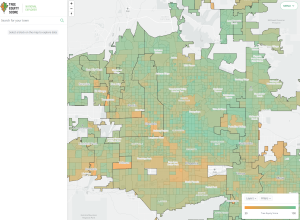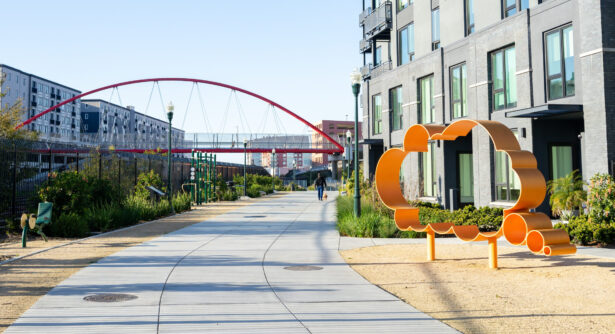
Supporting Resilient Communities & Clean-ups with Brownfields
Introduction
Building climate resilience is essential for areas across the country that are, or will soon be, impacted by the negative consequences of climate change. An expression that has increasingly become more popular in the past couple years, climate resilience is an area’s capacity to withstand and bounce back after natural disasters as well as a reflection of its adaptability to a changing environment. This concept is closely linked to climate justice issues as many of those most at risk to climate change are socio-and-economically disadvantaged populations burdened by historic pollution and without the mobility to simply move away from at-risk areas. To withstand and build resilience it is essential that we consider how infrastructure and agriculture are developed in the coming decades. Brownfields, with their significant density in urban areas, offer a large opportunity to assist communities in improving their resilience.
Brownfields are properties where reuse is made more difficult by contamination, or suspected contamination, of hazardous substances. They come in all shapes and sizes, from former industrial facilities and factories to shuttered gas stations and dry cleaners. All communities may have brownfields, however, disadvantaged urban communities bear the most burden.
Consequences of Climate Change
Disasters and crises rarely impact all communities equally. There are a number of reasons why disadvantaged communities are more likely to experience the harms of climate change. Three key threats where brownfield redevelopment can assist are in: extreme heat, natural disasters, and sea level rise.
Extreme Heat
Many areas in the inner city are feeling the heat as they experience urban heat islands. This occurs when roads, pavement, and other infrastructure re-emit the sun’s rays more than forests or water bodies. Trees and other green spaces can help reduce this effect through shade and evaporative cooling, making them an important component for redevelopment. Unfortunately, tree cover is not equitable. The non profit American Forests has developed a Tree Equity Score map that shows the poorest communities have 41% less tree coverage than the wealthiest ones. The resulting heat islands can have temperatures 1-7 degrees hotter than neighborhoods with more open space and trees. To address this challenge, many cities are investing in ‘cool’ surfaces that better reflect the sun’s heat, and mass tree planting programs. Phoenix has an urban forest master plan where they plan to cover 25% of the urban core with trees, especially South Phoenix which is the lowest income and the fewest trees.
The Equity Score Map of Phoenix shows large swaths of inequity in South Phoenix and the Grand Avenue Corridor
The interim use by Hayes Valley Farm in San Francisco included gardens and fruit trees. The site now features affordable housing with tree covered walkways.
Natural Disasters
Across the country, we have seen an increase in natural disasters such as fires and hurricanes. Despite this increase of threat, most new homes in California are built on the urban/forest boundary further increasing this risk. Meanwhile, Florida is the fastest growing state in the nation, even as it faces increased risks for climate-change-fueled hurricanes and sea level rise. This increased human footprint, as well as longer periods of drought and extreme weather raises the potential for devastation from wildfires and hurricanes. While many Americans say they consider climate change when they decide where to move, the fact is that cost of living and a desire to be near nature motivates people to move into harm’s way. Supporting infill such as inner city brownfield redevelopment over sprawl as well as proactive community planning and zoning can help mitigate this threat by providing desirable housing closer to urban cores and jobs, so people don’t feel the need to move to more dangerous environments.
Sea Level Rise
Sea level rise is another threat to coastal communities. Cities must consider a changing flood plane, and the use of wetlands can help by acting as buffers to storm surges. The India Basin Waterfront Park in San Francisco is being built on a former ship repair yard. The park contains habitat and wetland restoration and enhancement, Public access to green spaces, and supports social equity. It will also absorb storm surges, providing enhanced protection for the neighborhood. The EPA developed a guide to considering sea level rise during brownfields redevelopment that can assist with this type of planning.
Another concern of sea level rise is the changing water table. Sea water can put pressure on groundwater tables, forcing them up, closer to the surface, or sometimes above the surface. Not only can this create more flooding during storms like California saw this winter, it can push contamination that was once well underground to the surface. Brownfields in areas vulnerable to changes in the groundwater table are in increased need of cleanup to ensure these toxic chemicals don’t reemerge and recontaminate spaces.
The impacts of climate change vary from neighborhood to neighborhood. To understand the changes in your locality, it is useful to consult climate maps and change models such as those maintained by climate.gov or predictors of potential sea level rise like EarthTime.
Sustainable Resilient Brownfields
“Sustainable Resilient Remediation is an optimized solution to cleaning up and reusing hazardous waste sites that limits environmental impacts, maximizes social and economic benefits, and creates resilience against the increasing threat of extreme weather events.” (Interstate Technology & Regulatory Council, 2021 )
An expansion of sustainable remediation, sustainable resilient cleanup and reuse of contaminated lands includes design in consideration of climate change impacts, helps achieve equitable community revitalization, and supports local, national, and global sustainable development goals while meeting regulatory requirements to protect human health and welfare.
Climate change impacts can undermine the effectiveness of original site remediation design, and alter the toxicity, transport and exposure mechanisms of contaminants. Smart brownfield redevelopment anticipates these impacts in clean-up design, and utilizes brownfields to improve a community’s overall resilience and response to climate change. For example, a study for the City of San Francisco used a life cycle assessment of greenhouse gas (GHG) emissions to compare the redevelopment of brownfields to the development of greenfields (previously undeveloped land), and determined that brownfield land redevelopment could lead to an overall reduction of 14% of San Francisco 2010 GHG emission by preventing the lengthy commutes dictated by urban sprawl.

Supporting Vulnerabilities and other Responses to Climate Change
Climate resilience is an environmental justice issue as many of those most vulnerable in the inner-cities are those who lack the resources to simply move to safer locations; people already disadvantaged by industrial pollution, lack of opportunity, and other factors. Brownfield redevelopment can be part of the solution by helping to generate local jobs, more open areas for green space and trees, affordable housing without sprawl, and an opportunity for local knowledge and community voices to shine through. Now more than ever, there is support in the shape of climate resilience grants, money for brownfield investigation and clean-up (such as EPA’s MARC program and California’s Equitable Community Revitalization grant).
If you have redeveloped a Brownfield with Climate Resilience at the forefront of your execution, we would love to hear from you in our Sustainability Showcase Challenge where we will share innovations in sustainability and climate resilience as best practices for others.
More Resources
-NYC Climate Resiliency Design Guidelines
-California Climate Adaptation Strategy
-Coastal Ecosystems (SURF) Webinar
-ITRC Sustainable Resilient Remediation
Maco, B., Bardos, P., Coulon, F., et al. (2018). Resilient remediation: Addressing extreme weather and climate change, creating community value. Remediation, 29(1), 7–18. https://onlinelibrary.wiley.com/doi/10.1002/rem.21585






